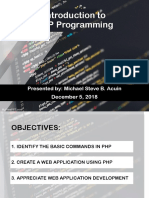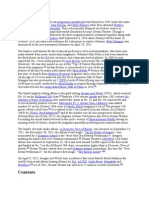Server Side Scripting PHP
Uploaded by
markgreezy2k19Server Side Scripting PHP
Uploaded by
markgreezy2k19SERVER SIDE SCRIPTING
PHP
What is PHP?
PHP stands for PHP: Hypertext Preprocessor
PHP started to be known as Personal Home Page
PHP is a server-side scripting language, like ASP
PHP scripts are executed on the server
PHP supports many databases (MySQL, Informix, Oracle, Sybase, Solid,
PostgreSQL, Generic ODBC, etc.)
PHP is an open source software (OSS)
PHP is free to download and use
What is PHP?...
Loosely typed scripting language
Interpreted at runtime
Commonly used to build web applications
PHP is easy to learn and runs efficiently on the server side
What is a PHP File?
PHP files may contain text, HTML tags and scripts
PHP files are returned to the browser as plain HTML
PHP files have a file extension of “.php”
Introduction
Interpreted language
•scripts are parsed at run-time
rather than compiled beforehand
•Executed on the server-side
•Source-code not visible by client
‘View Source’ in browsers does
not display the PHP code
•Various built-in functions allow
for fast development
•Compatible with many popular
databases
PHP Introduction
The PHP code is enclosed in special start and end processing instructions
<?php and ?> that allow you to jump into and out of “PHP mode”.
PHP Introduction…
PHP code is executed on the server, generating HTML which is then sent to
the client.
The client would receive the results of running that script, but would not
know what the underlying code was.
PHP Hello World
<html>
<head>
<title>PHP Test</title>
</head>
<body>
<?php echo ‘<p>Hello World</p>’; ?>
</body>
</html>
PHP Hello World…
It renders as HTML that looks like this:
<html>
<head>
<title>PHP Test</title>
</head>
<body>
<p>Hello World</p>
</body>
</html>
PHP Hello World…
This program is extremely simple.
All it does is display: Hello World using the PHP echo() statement.
Think of this as a normal HTML file which happens to have a set of special
tags available to you that do a lot of interesting things.
PHP hello world…
> Script Tag
<html>
<head>
<title>PHP Test</title>
</head>
<body>
<script language=“php”> print ‘<p>Hello World</p>’;
</script>
</body>
</html>
PHP Comments
In PHP, we use // or # to make a single-line comment or /* and */ to make a large
(multiline) comment block.
<html>
<body>
<?php
//This is a comment
# This is also a comment
/*
This is
a comment
block
*/
VARIABLES $VAR
PHP
PHP Variables
Variables are used for storing values, like text strings, numbers or arrays.
When a variable is declared, it can be used over and over again in your
script.
All variables in PHP start with a $ sign symbol.
The correct way of declaring a variable in PHP:
$var_name = value;
PHP Variables…
<?php
$txt = “Hello World!”;
$x = 16;
?>
PHP is a Loosely Typed Language
In PHP, a variable does not need to be declared before adding a value to it.
In the example above, you see that you do not have to tell PHP which data
type the variable is.
PHP automatically converts the variable to the correct data type, depending
on its value.
PHP Variables…
A variable name must start with a letter or an underscore “_” – not a
number, after the dollar sign
A variable name can only contain alpha-numeric characters, underscores
(a-z. A-Z, 0-9, and _)
A variable name should not contain spaces. If a variable name is more than
one word, it should be separated with an underscore ($my_string) or with
capitalization ($myString)
Introduction
Hello World!: An Example
<?php echo “Hello World!”; ?>
<?php
$greeting = “Hello World!”;
echo $greeting;
php?>
created by zelalem Abera-HilCoe-Web - Technology 17
Basic PHP Syntax
Each code line in PHP must end with a semicolon.
Basic PHP Syntax…
> Echo & Print
There are two basic statements to output text with PHP:
echo (relatively faster) and
Works very similarly
Basic PHP Syntax…
> Echo & Print
print is similar to echo.
Differences
echo doesn’t return a value
You cannot use comma separated list of variables. Use echo instead!
Basic PHP Syntax…
> Echo & Print
echo “Hello World!<br /><br/>”
echo “Some
multi line text”;
$foo = “Hello World!”;
$hello = “Hello”;
echo “Hi $foo”; //Hi Hello World!
echo ‘Hi $foo’; // Hi $foo (Taken literally)
echo $foo, $hello; // comma separate a list of variables
echo ‘some text’, ‘some text’, ‘<br />; // comma separated values
echo “(again, ”, “and again!)”;
PHP Basic Types
String
$str = “I am a string :)”;
Integer
$int = 22;
Boolean
$bool = TRUE; // with echo, displayed as 1 and empty value for 0.
Float
$float = 1.234;
$float2 = 3.1415927;
$float3 = 5.3e7;
PHP Basic Types
echo gettype($str); // “string”
is_string($bool) // return true or false (1 or 0)
echo gettype($int); // “integer”
is_int($int) // return true or false (1 or 0)
echo gettype($bool); // “boolean”
echo gettype($float); // “double”
PHP Basic Types
> Integers
$int = 1000; // base 10
$int_8 = 01000; // leading zero, octal (base 8)
$int_16 = 0x01010; // leading 0x, hexadecimal (base 16)
PHP Basics
> isset(), empty(), and unset
isset(): check a variable is set or not
empty(): an empty string or something with a value of zero
unset(): take the value away from a variable
Example:
<? php
$foo = “I am set!”;
$foo2 = “I am also set!”;
$int = 22;
$bool = TRUE;
?>
PHP Basics
> isset(), empty(), and unset…
Example:
echo isset($foo); //1
echo isset($foo2); //1
echo issset($int); //1
echo isset($bool); //1
echo isset($bool2); //empty (nothing is displayed)
Empty allows you to check a variable is an empty string or zero
echo empty($foo); // empty (nothing is displayed) (1 if $foo has no
value)
echo unset($foo); // no longer set
PHP Basics
> NULL, is_null()
$foo = NULL; // note that null is written NULL
$foo2 = NULL;
$foo3 = NULL;
$foo4 = “Hello World!”;
echo isset($foo3); // nothing is displayed (false or 0)
echo isset($foo4); // 1
is_null($foo3); // 1
is_null($foo4); // nothing is displayed (false or 0)
PHP Basics
> Constants
A constant is an identifier (name) for a simple value.
The value cannot change during the execution of the script
Define:
define(‘HELLO’, ‘Hello, PHP Code’);
echo HELLO;
As of PHP 5.3
const HELLO = ‘Hello, PHP Code’;
echo HELLO; // Hello, PHP Code
PHP Basics
> Constants
Example:
define(“UPPER_LIMIT”, 1000); // Recommended to write using uppercase
echo UPPER_LIMIT;
Used for settings like minimum, maximum and server name.
OPERATORS AND CONDITIONAL STATEMENTS
PHP
PHP Operators
Operators are used to operate on values. There are four classifications of
operators:
Arithmetic
Assignment
Comparison
Logical
PHP Operators…
> Arithmetic Operators
Operator Description Example Result
+ Addition X=2 4
X+2
- Subtraction X=2 3
5–X
* Multiplication X=4 20
X*5
/ Division 3
2.5
% Modulus 5%2 1
(division 10%8 2
remainder) 10%2 0
++ Increment X=5 X=6
X++
-- Decrement X=5 X=4
X--
PHP Operators…
> Assignment Operators
Operator Example Is The Same As
= x=y x=y
+= x+=y x=x+y
-= x-=y x=x-y
*= x*=y x=x*y
/= x/=y x=x/y
.= x.=y x=x.y
%= x%=y x=x%y
PHP Operators…
> Comparison Operators
Operator Description Example
== Is equal to 5==8 returns false
!= Is not equal 5!=8 returns true
<> Is not equal 5<>8 returns true
> Is greater than 5>8 returns false
< Is less than 5<8 returns false
>= Is greater than or equal to 5>=8 returns false
<= Is less than or equal to 5<=8 returns true
PHP Operators…
> Logical Operators
Operator Description Example
&& and x=6
y=3
(x < 10 && y > 1) returns
true
|| or x=6
y=3
(x == 5 || y == 5) returns
false
! not x=6
y=3
!(x==y) returns true
PHP Conditional Statements
Very often when you write code, you want to perform different actions for
different decisions.
You can use conditional statements in your code to do this.
In PHP we have the following conditional statements…
PHP Conditional Statements…
if statement – use this statement to execute some code only if a specified
condition is true
if…else statement – use this statement to execute some code if a condition
is true and another code if the condition is false
if...elseif…else statement – use this statement to select one of several
blocks of code to be executed
switch statement – use this statement to select one of many blocks of code
to be executed.
PHP Conditional Statements…
The following example will output “Have a nice weekend!” if the current day
is Friday:
<html>
<body>
<?php
$d=date(“D”);
if ($d==“Fri”) echo “Have a nice weekend!”;
?>
</body>
</html>
PHP Conditional Statements…
Use the if…else statement to execute some code if a condition is true and another
code if a condition is false.
<html>
<body>
<?php
$d=date(“D”);
if ($d==“Fri”)
echo “Have a nice weekend!”;
else
echo “Have a nice day!”;
?>
</body>
</html>
PHP Conditional Statements…
If more than one line should be executed if a condition is true/false, the lines should be enclosed
within curly braces {}
<html>
<body>
<?php
$d=date(“D”);
if ($d==“Fri”)
{
echo “Hello!<br />”;
echo “Have a nice weekend!”;
echo “See you on Monday!”;
}
?>
</body>
</html>
PHP Conditional Statements…
The following example will output “Have a nice weekend!” if the current day is Friday, and “Have
a nice Sunday!” if the current day is Sunday. Otherwise it will output “Have a nice day!”
<html>
<body>
<?php
$d=date(“D”);
if ($d==“Fri”)
echo “Have a nice weekend!”;
elseif ($d==“Sun”)
echo “Have a nice Sunday!”;
else
echo “Have a nice day!”;
?>
</body>
</html>
PHP Conditional Statements…
> Example
<?php if ($bool == TRUE) { ?>
<table>
<tr>
<td></td>
<td></td>
</tr>
<tr>
<td></td>
<td></td>
</tr>
</table>
PHP Conditional Statements…
> Switch Statement
Use the switch statement to select one of many blocks of code to be executed.
switch (n)
{
case value1:
code to be executed if n== value1;
break;
case value2:
code to be executed if value2;
break;
default:
code to be executed if n is different from both value1 and value2;
}
PHP Conditional Statements…
For switches, first we have a single expression n (most often a variable),
that is evaluated once.
The value of the expression is then compared with the values for each case
in the structure. If there is a match, the block of code associated with the
case is executed.
Use break to prevent the code from running into the next case
automatically. The default statement is used if no match is found.
PHP Conditional Statements…
<html>
<body>
<?php
switch ($x)
{
case 1:
echo “Number 1”;
break;
case 2:
echo “Number 2”;
break;
PHP Conditional Statements…
case 3:
echo “Number 3”;
break;
default:
echo “No number between 1 and 3”;
}
?>
</body>
</html>
PHP Loops
Often when you write code, you want the same block of code to run over
and over again in a row.
Instead of adding several almost equal lines in a script we can use loops to
perform a task like this.
PHP Loops…
while – loops through a block of code while a specified condition is true
do…while – loops through a block of code once, and then repeats the loop
as long as a specified condition is true
for – loops through a block of code a specified number of times
foreach – loops through a block of code for each element in an array
PHP Loops…
> While
<?php
$x = 0;
while ($x < 5) {
echo ‘.’;
$x++;
}
?>
PHP Loops…
> While
<?php
$x = 0;
while ($x < 5) :
echo ‘.’;
$x++;
endwhile;
?>
PHP Loops
> Do … While
<?php
$x = 1;
do
{
$x++;
echo “The number is ” . $x . “<br />”;
}
while ($i<=5);
?>
PHP Loops…
> For
<?php
for ($x = 0; $x < 5; $x++) {
echo ‘.’;
}
?>
PHP Loops…
> Foreach
<?php
$x = array(0, 1, 2, 3, 4);
foreach ($x as $y) {
echo $y;
}
?>
PHP Loops…
> Foreach (Key/Value Pairs)
<?php
$talks = array(
‘php’ => ‘Intro to PHP’,
‘ruby’ => ‘Intro to Ruby’
);
foreach ($talks as $id => $name) {
echo “$name is talk ID $id.”;
echo “<br />”;
}
?>
PHP Loops…
> Infinite Loops
With an infinite loop you have to hit stop on the browser, or add some
syntactically error on your php file and save it to stop the loop.
ARRAYS $NAMES=ARRAY();
PHP
PHP Arrays
An array variable is a storage area holding a number or text. The problem
is, a variable will hold only one value.
An array is a special variable, which can store multiple values in one single
variable.
PHP Arrays…
If you have a list of items (a list of car names, for example), storing the cars
in single variables could look like this:
$cars1=“Saab”;
$cars2=“Volvo”;
$cars3=“BMW”;
PHP Arrays…
However, what if you want to loop through the cars and find a specific one?
And what if you had not 3 cars, but 300?
The best solution here is to use an array.
An array can hold all your variable values under a single name. And you can
access the values by referring to the array name.
Each element in the array has its own index so that it can be easily
accessed.
PHP Arrays…
In PHP, there are three kind of arrays:
Numeric array – An array with a numeric index
Associative array – An array where each ID key is associated with a value
Multidimensional array – An array containing one or more arrays
PHP Numeric Arrays
A numeric array stores each array element with a numeric index.
There are two methods to create a numeric array.
Example:
Automatic index assignment (the index starts at 0)
$cars = array(“Saab”, “Volvo”, “BMW”, “Toyota”);
Manual index assignment
$cars[0] = “Saab”;
$cars[1] = “Volvo”;
$cars[2] = “BMW”;
$cars[3] = “Toyota”;
PHP Numeric Arrays…
In the following example you access the variable values by referring to the
array name and index:
<?php
$cars[0] = “Saab”;
$cars[1] = “Volvo”;
$cars[2] = “BMW”;
$cars[3] = “Toyota”;
echo $cars[0] . “ and “ . $cars[1] . “ are Swedish cars.”;
?>
Output: Saab and Volvo are Swedish cars.
Getting the length of an array
The count function is used to return the length of an array.
<?php
$cars = array("Volvo", "BMW", "Toyota");
echo count($cars);
?>
<?php
$cars = array("Volvo", "BMW", "Toyota");
echo sizeof($cars);
?>
<?php
$cars = array("Volvo", "BMW", "Toyota");
print_r($cars); // Array ( [0] => Volvo [1] => BMW [2] => Toyota )
?>
PHP Associative Arrays…
With an associative array, each ID key is associated with a value.
When storing data about specific named values, a numerical array is not
always the best way to do it.
With associative arrays we can use the values as keys and assign values to
them.
PHP Associative Arrays
Example: Assign age to different persons:
$ages = array(“Peter”=>32, “Quagmire”=>30, “Joe”=>34);
Another way to write it could be
$ages[‘Peter’] = “32”;
$ages[‘Quagmire’] = “30”;
$ages[‘Joe’] = “34”;
PHP Associative Arrays…
The ID keys can be used in a script:
<?php
$ages[‘Peter’] = “32”;
$ages[‘Quagmire’] = “30”;
$ages[‘Joe’] = “34”;
echo “Peter is “ . $ages[‘Peter’] . “ years old.”;
?>
Output: Peter is 32 years old.
PHP Multidimensional Arrays
In a multidimensional array, each element in the main array can also be an
array.
And each element in the sub-array can be an array, and so on.
PHP Multidimensional Arrays…
Multidimensional array, with manually assigned ID keys:
$families = array(“Griffin”=>array(“Peter”, “Lois”, “Megan”),
“Quagmire”=>array(Glenn”), “Brown”=>array(“Cleveland”,
“Loretta”, “Junior”));
$families[2][0]
Multidimensional array, with automatically assigned ID keys:
$cars = array(array("Volvo",22,18), array("BMW",15,13),
array("Saab",5,2), array("Land Rover",17,15));
PHP Multidimensional Arrays…
Lets try displaying a single value from the array above:
echo “Is “ . $families[‘Griffin’][2] . “ a part of the Griffin family?”;
Output: Is Megan a part of the Griffin family?
Exercise
Calculate the average expense for each expenses in each term from the
following array?
$expenses=array(30,44,55,11,24);
Hint:-use count(expense) for the number of expenses.
PHP String Concatenation
The concatenation operator (.) is used to put two string values together.
To concatenate two string variables together, use the concatenation operator:
<?php
$txt1 = “Hello World!”;
$txt2 = “What a nice day!”;
echo $txt1 . “ ” . $txt2;
?>
OUTPUT
Hello World! What a nice day!
PHP String Char Index
Strings are arrays.
Example:
<?php
$str = “0123456789”;
$str2 = $str;
$str2[4] = “X”;
$str2[6] = “Y”;
?>
PHP String Char Index
<?php
$str3 = “The string ends in escape:”;
$str3 .= chr(32).chr(55); // add a space and the number 7 as
two ascii characters
echo $str3;
for ($i = 0; $i < strlen($str3); $i++)
echo $str3[$i];
?>
PHP Strings
> Using the strlen() function
The strlen() function is used to find the length of a string.
Let’s find the length of our string “Hello world!”:
<?php
echo strlen(“Hello world!”);
?>
PHP Strings…
> Important String Functions
Comparison
strcmp(str1, str2); // returns 0, <0, >0
String Position
strpos(haystack, needle, offset[optional); //returns index (or FALSE)
Needle is the string you want to find; haystack is the string to be searched.
Offset: optional. Offset from the left. Starting position
String Replace
str_replace(“%name%”, $name, $template);
str_replace($arr, $repwith, $originalstring); // can also take array and return new string
PHP Strings…
> Important String Functions…
Sub String
substr($str, 1, 5); // the last parameter is optional, returns a string
Also takes negative values.
Get character index
$str{4}
Case Functions
strupper($str); // returns a string (upper case)
strlower($str); // returns a string (lower case)
ucfirst($str); // capitalize first letter of first word
ucwords($str); // capitalize first letter of every word
PHP Strings…
> Important String Functions…
Cleaning up strings
ltrim($str); // removes spaces on the left of a string
rtrim($str); // removes spaces on the right of a string
chop($str); // removes spaces on the right of a string (alias for rtrim)
trim($str); // removes spaces on the left and right of a string
PHP Strings…
> Literal Single Quotes
<?php
$x = 2;
Echo ‘I ate $x cookies.’;
// I ate $x cookies.
?>
PHP Strings…
> Double Quotes
<?php
$x = 2;
Echo “I ate $x cookies.”;
// I ate 2 cookies.
?>
PHP Strings…
> Literal Double Quotes
<?php
$x = 2;
Echo “I ate \$x cookies.”;
// I ate $x cookies.
?>
PHP Strings…
> Curly Brace – Double Quotes
<?php
$x = 2;
Echo “I ate {$x} cookies.”;
// I ate 2 cookies.
?>
The PHP Date() Function
Wednesday/04/2024
<?php
echo "Today is " . date("Y/m/d") . "<br>";
echo "Today is " . date("Y.m.d") . "<br>";
echo "Today is " . date("Y-m-d") . "<br>";
echo "Today is " . date("l");
?> Day of d 01
Month
Day of J 1
M Jan Month
F January Day of l Monday
Week
m 01
Day of D Mon
n 1 Week
created by zelalem Abera-HilCoe-Web - Technology 82
Exercise
Write a php code which out puts the following date?
Wednesday/04/2019
created by zelalem Abera-HilCoe-Web - Technology 83
PHP Functions
To keep the script from being executed when the page loads, you can put it
into a function.
A function will be executed by a call to the function.
You may call a function from anywhere within a page.
In PHP – there are more than 700 built-in functions available.
PHP Functions…
A function will be executed by a call to the function.
function functionName()
{
code to be executed;
}
Give the function a name that reflects what the function does
The function name can start with a letter or underscore (not a number)
PHP Functions…
A simple function that writes a name when it is called:
<html>
<body>
<?php
function wirteName()
{
echo “Tadios N. Demma”;
}
echo “My name is “;
writeName();
?>
</body>
</html>
PHP Functions…
Adding parameters…
To add more functionality to a function, we can add parameters.
A parameter is just like a variable.
Parameters are specified after the function name, inside the
parentheses.
PHP Functions…
A function that write different first names, but equal last name:
<html>
<body>
<?php
function writeName($fname)
{
echo $fname . “ Demma. <br />”;
}
echo “My name is ”;
writeName(“Tadios”);
PHP Functions…
A function that write different first names, but equal last name…
…
echo “My sister’s name is ”;
writeName(“Martha”);
echo “My brother’s name is ”;
writeName(“Ezra”);
?>
</body>
</html>
Passing by reference
Use the & sign on the function so that variables can be passed by a
reference.
function my_function(&$myparameter)
{
// your function definition
}
Variable Scope
Variables that are not defined inside a function are visible at the page level.
Variables inside a function are only visible inside the function definition.
Page level variables are not global variables in PHP.
To set a variable as global use the global variable.
global $myVariable;
$GLOBALS[‘str’] = “sample data”;
echo $str;
PHP Include File
Server Side Includes (SSI) are used to create functions, headers, footers, or
elements that will be reused on multiple pages.
You can insert the content of a file into a PHP file before the server executes
it, with the include() or require() function.
The two functions are identical in every way, except how they handle
errors.
The include() function generates a warning (but the script will continue
execution) while the require() function generates a fatal error (and the
script execution will stop after the error).
The include() function
The include() function takes all the text in a specified file and copies it into
the file that uses the include function.
Assume that you have a standard header file, called “header.php”. To
include the header file in a page, use the include() function, like this:
<html> <body>
<?php include("header.php"); ?>
<h1>Welcome to my home page</h1>
<p>Some text</p>
</body> </html>
//lets assume the “header.php” file <?php echo “from the header file”; ?>
The include() Function…
menu.php
<a href="http://www.mywebsite.com/index.php">Home</a> | <a
href="http://www.mywebsite.com/about.php">About Us</a> | <a
href="http://www.mywebsite.com/contact.php">Contact Us</a>
index.php
<html><head>
<title>Default Page</title> </head>
<body>
<?php include("menu.php"); ?>
<h1>Welcome to my homepage</h1>
<p>Some text</p>
The require() Function
The require() function is identical to include(), except that it handles errors
differently.
The include() function generates a warning (but the script will continue
execution) while the require() function generates a fatal error (and the
script will stop after the error).
Include vs Required
<html> <body> <html> <body>
<?php include("wrongFile.php"); <?php require("wrongFile.php");
echo "Hello World!"; ?> echo "Hello World!"; ?>
</body> </html>
</body> </html>
PHP Forms and User Input
The PHP $_GET and $_POST variables are used to retrieve information from
forms, like user input.
PHP Form Handling
The most important thing to notice when dealing with HTML forms and PHP is that any
form element in an HTML page will automatically be available to your PHP scripts.
PHP $_GET
The $_GET variable is used to collect values from a form with
method=“get”.
The $_GET variable
The $_GET variable is an array of variable names and values sent by the HTTP GET
method.
Information sent from a form with the GET method is visible to everyone (it will be
displayed in the browser’s address bar) and it has limits on the amount of information to
send (max. 100 characters).
PHP Forms - $_GET Variable
<form action=“welcome.php” method=“get”>
Name: <input type=“text” name=“fname” />
Name: <input type=“text” name=“age” />
<input type=“submit” />
</form>
When the user clicks the “Submit” button, the URL sent could look something
like this:
http://www.somewebsite.com/welcome.php?fname=Peter&age=37
$_GET Variable…
> welcome.php
<html><body>
Welcome
<?php
echo $_GET[“fname”];
?>
<br/>
You are
<?php
echo $_GET[“age”];
?>
years old.
PHP $_POST
The $_POST variable is used to collect values from a form with
method=“post”
The $_POST variable is an array of variable names and values sent by the
HTTP POST method.
The $_POST variable is used to collect values from a form with the
method=“post”. Information sent from a from with the POST method is
invisible to others and has no limits on the amount of information to send.
PHP Forms - $_POST Variable
<form action=“welcome.php” method=“post”>
Name: <input type=“text” name=“fname” />
Name: <input type=“text” name=“age” />
<input type=“submit” />
</form>
When the user clicks the “Submit” button, the URL sent could look something
like this:
http://www.somewebsite.com/welcome.php
So where is the data, the data is hidden in the request object.
$_POST Variable…
> welcome.php
<html><body>
Welcome
<?php
echo htmlspecialchars($_POST[“name”]);
?>
<br/>
You are
<?php
echo (int)$_ POST[“age”];
?>
years old.
$_POST Variable…
htmlspecialchars() – makes sure any characters that are special in html are
properly encoded so people can’t inject HTML tags or JavaScript into your
page.
(int) – For the age field, since we know it is a number, we can just convert it
to an integer which will automatically get rid of any stray characters. The
$_POST[‘name’] and $[‘age’] variables are automatically set for you by PHP.
Why use $_POST?
Variables sent with HTTP POST are not shown in the URL
Variables have no length limit
However, because the variables are not displayed in the URL, it is not
possible to bookmark the page.
The $_REQUEST Variable
The PHP $_REQUEST variable contains the contents of both $_GET, $_POST
and $_COOKIE
The PHP $_REQUEST variable can be used to get the result from form data
sent with both the GET and POST methods.
Example
Welcome <?php echo $_REQUEST["name"]; ?>.<br />
You are <?php echo $_REQUEST["age"]; ?> years old!
PHP File Handling
Opening a File
The fopen() function is used to open files in PHP.
The first parameter of this function contains the name of the file to be opened and the
second parameter specifies in which mode the file should be opened:
<html>
<body>
<?php
$file=fopen(“welcome.txt”, “r”);
?>
</body>
</html>
Note: If the fopen() function is unable to open the specified file, it
returns 0 (false)
PHP File Handling…
The file may be opened in one of the following mode
Modes Description
r Read only. Starts at the beginning of the file
r+ Read/Write. Starts at the beginning of the file
w Write only. Opens and clears the contents of file; or creates a new file if
it doesn’t exist.
w+ Read/Write. Opens and clears the contents of file; or creates a new file if
it doesn’t exist.
a Append. Opens and writes to the end of the file or creates a new file if it
doesn’t exist.
a+ Read/Append. Preserves file content by writing to the end of the file
x Write only. Creates a new file. Returns FALSE and an error if file already
exists
x+ Read/Write. Creates a new file. Returns FALSE and an error if file already
Closing a file
The fclose() function is used to close an open file:
<?php
$file = fopen(“text.txt”, “r”);
//some code to be executed
fclose($file);
?>
Check end-of-file
The feof() function checks if the “end-of-file” (EOF) has been reached.
The feof() function is useful for looping through data of unknown length.
Note: You cannot read from files opened in w, a, and x mode!
if (feof($file)) echo “End of file”;
Reading a file line by line
The fgets() function is used to read a single line from a file.
Note: After a call to this function the file pointer has moved to the next line.
Example: The example below reads a file line by line, until the end of file is
reached:
<?php
$file = fopen(“welcome.txt”, “r”) or exit(“Unable to open file!”);
//Output a line of the file until the end is reached
while(!feof($file))
{
echo fgets($file) . “<br />”;
}
fclose($file);
?>
Reading a file character by character
The fgetc() function is used to read a single character from a file.
Note: After a call to this function the file pointer moves to the next character.
Example: The example below reads a file character by character, until the
end of the file is reached:
<?php
$file = fopen(“welcome.txt”, “r”) or exit(“Unable to open file!”);
while (!feof($file))
{
echo fgetc($file);
}
fclose($file);
?>
Writing to a file
The fwrite() function is used to write to a file.
Exmaple:
<?php
$file = fopen(“welcome.txt”, “w”) or exit(“Unable to open
file!”);
if ($file)
fwrite($file, “Some Text”);
fclose($file);
?>
PHP file upload
With PHP, it is possible to upload files to the server.
To allow users to upload files from a form can be very useful.
Look at the following HTML form for uploading files:
<html>
</body>
<form action=“upload_file.php” method=“post” enctype=“multipart/form-
data”>
<label for=“file”>Filename:</label>
<input type=“file” name=“file” id=“file” /> <br/>
<input type=“submit” name=“submit” value=“Submit” />
</form>
</body>
</html>
PHP file upload…
> Things to notice on the previous slide
The enctype attribute of the <form> tag specifies which content-
type to use when submitting the form. “multipart/form-data” is
used when a form requires binary data, like the contents of a file,
to be uploaded.
The default is: application/x-www-form-urlencoded
The type=“file” attribute of the <input> tag specifies that the
input should be processed as a file. For example, when viewed in
a browser, there will be a browse-button next to the input field
Note: Allowing users to upload files is a big security risk. Only
permit trusted users to perform file uploads.
Creating the upload script
<?php
if ($_FILES[“file”][“error”] > 0) {
echo “Error: ” . $_FILES[“file”][“error”] . “<br />”;
}
else {
echo “Upload: ” . $_FILES[“file”][“name”] . “<br />”;
echo “Type: ” . $_FILES[“file”][“type”] . “<br />”;
echo “Size: ” . ($_FILES[“file”][“size”] / 1024) . “Kb<br />”;
echo “Stored in: ” . $_FILES[“file”][“tmp_name”] . “<br />”;
}
?>
By using the global PHP $_FILES array you can upload files from a client computer
Creating the upload script…
The first parameter is the form’s input name and the second index can be
either “name”, “type”, “size”, “tmp_name” or “error”. Like this:
$_FILES[“file”][“name”] – the name of the uploaded file
$_FILES[“file”][“type”] – the type of the uploaded file
$_FILES[“file”][“size”] – the size in bytes of the uploaded file
$_FILES[“file”][“tmp_name”] – the name of the temporary copy of the file stored on the
server
$_FILES[“file”][“error”] – the error code resulting from the file upload
Saving the uploaded file
The temporary copied files disappears when the script ends. To store the uploaded file we need to
copy it to a different location:
<?php
if ((($_FILES["file"]["type"] == "image/gif") || ($_FILES["file"]["type"] == "image/jpeg") ||
($_FILES["file"]["type"] == "image/pjpeg") ) && ($_FILES["file"]["size"] < 20000))
{
if ($_FILES["file"]["error"] > 0)
{
echo "Return Code: " . $_FILES["file"]["error"] . "<br />";
}
else
{
echo "Upload: " . $_FILES["file"]["name"] . "<br />";
echo "Type: " . $_FILES["file"]["type"] . "<br />";
echo "Size: " . ($_FILES["file"]["size"] / 1024) . " Kb<br />";
Saving the uploaded file…
if (file_exists("upload/" . $_FILES["file"]["name"]))
{
echo $_FILES["file"]["name"] . " already exists. ";
}
else
{
move_uploaded_file($_FILES["file"]["tmp_name"], "upload/" . $_FILES["file"]["name"]);
echo "Stored in: " . "upload/" . $_FILES["file"]["name"];
}
}
}
else
{
echo "Invalid file";
}
Saving the uploaded file…
The script above checks if the file already exists, if it does not, it copies the
file to the specified folder.
Note: This example saves the file to a folder called “upload”
PHP Sessions
A PHP session variable is used to store information about, or change
settings for a user session.
Session variables hold information about one single user, and are available
to all pages in one application.
Application of sessions
Save the user’s name in the session so that you don’t have to query the
database every time you need
Setting font preferences for users.
And others…
Sessions work by creating a unique id (UID) for each visitor and store
variables based on this UID.
How to of a Session
> Starting a PHP Session
Before you can store user information in you PHP session, you must first
start up the session.
Note: The session_start() function must appear BEFORE the <html> tag:
<?php
session_start();
?>
<html></body>
</body></html>
The code above will register the user’s session with the server, allow you to
start saving user information, and assign a UID for the user’s session.
How to of a Session
> Storing a Session Variable
The correct way to store and retrieve session variables is to use the PHP $_SESSION
variable:
<?php
session_start();
// store session data
$_SESSION['views']=1;
?>
<html> <body>
<?php
//retrieve session data
echo "Pageviews=". $_SESSION['views']; ?>
</body> </html>
A simple page view counter
The isset() function checks if the “views” variable has already been set.
If “views” has been set, we can increment our counter. If “views” doesn’t
exist, we create a “views” variable, and set it to 1:
<?php
session_start();
if(isset($_SESSION['views']))
$_SESSION['views']=$_SESSION['views']+1;
else
$_SESSION['views']=1;
echo "Views=". $_SESSION['views'];
MySQL
MySQL is a database server
MySQL is ideal for both small and large applications
MySQL supports standard SQL
MySQL compiles on a number of platforms
MySQL is free to download and use
MySQL is the most popular open source database server.
Connecting to MySQL Database
Before you can access and work with data in a database, you must create a
connection to the database.
In PHP, this is done with the mysqli_connect() function.
Syntax
mysqli_connect(servername, username, password);
Parameter Description
servername Optional. Specifies the server to connect to.
Default value is “localhost:3306”
username Optional. Specifies the username to login with.
Default value is the name of the user that owns
the server process
password Optional. Specifies the password to log in with.
Default is “”
Connecting to MySQL Database…
Example:
In the following example we store the connection in a variable ($con) for later use in the
script. The “die” part will be executed if the connection fails:
<?php
$con = mysqli_connect("localhost", "root", "P@ssw0rd");
if (!$con)
{
die('Could not connect: ' . mysqli_connect_error());
}//some code
?>
Closing a connection
The connection will be closed as soon as the script ends. To close the
connection before, use the mysqli_close() function.
<?php
$con = mysqli_connect("localhost", "root", "P@ssw0rd");
if (!$con)
{
die('Could not connect: ' . mysqli_connect_error());
}//some code
mysqli_close($con);
?>
Create Database and Tables
Create a Database
The CREATE DATABASE statement is used to create a database in MySQL.
Syntax
CREATE DATABASE database_name
To get PHP to execute the statement above we must use the mysqli_query()
function. This function is used to send a query or command to a MySQL
connection.
Create Database Example
Create a database called my_db
<?php
$con = mysqli_connect("localhost", "root", "P@ssw0rd");
if (!$con)
{
die('Could not connect: ' . mysqli_connect_error());
}
if (mysqli_query($con, "CREATE DATABASE my_db"))
{
echo "Database created";
Create Database Example…
else
{
echo "Error creating database: " .mysqli_error($con);
}
mysqli_close($con);
?>
Creating Table
The following example shows how you can create a table named “person”, with
three columns. The column names will be “FirstName”, “LastName” and “Age”:
<?php
$con = mysqli_connect("localhost","root","P@ssw0rd");
if (!$con)
{
die('Could not connect: ' . mysqli_connect_error());
}
// Create database
if (mysqli_query($con, "CREATE DATABASE my_db"))
{
Creating Table…
echo "Database created";
}
else
{
echo "Error creating database: " . mysqli_error($con);
}
// Create table in my_db database
mysqli_select_db($con, "my_db");
$sql = "CREATE TABLE person ( FirstName varchar(15), LastName varchar(15),
Age int )";
mysqli_query($con, $sql);
mysqli_close($con);
Creating Table…
Important: A database must be selected before a table can be created.
The database is selected with the mysqli_select_db() function.
Note: When you create a database field of type varchar, you must specify
the maximum length of the field, e.g. varchar(15).
Insert Data into Database Table
<?php
$con = mysqli_connect("localhost","root","P@ssw0rd", "my_db");
if (!$con) { die('Could not connect: ' . mysqli_connect_error()); }
mysqli_query($con, "INSERT INTO person (FirstName, LastName,
Age) VALUES
('Tadios', 'Demma', '35')");
mysqli_query($con, "INSERT INTO person (FirstName, LastName,
Age) VALUES
('Ezra', 'Demma', '33')");
mysqli_close($con);
?>
Insert a Data From a Form into a Database
//register.htm
<html><body>
<form action="insert.php" method="post">
Firstname: <input type="text" name="firstname" />
Lastname: <input type="text" name="lastname" />
Age: <input type="text" name="age" />
<input type="submit" value= "register" />
</form>
</body> </html>
Insert a Data From a Form into a Database…
//Insert.php
<?php
$con = mysqli_connect("localhost","root","P@ssw0rd", "my_db");
if (!$con) { die('Could not connect: ' . mysqli_connect_error()); }
$sql="INSERT INTO person (FirstName, LastName, Age) VALUES
('$_POST[firstname]','$_POST[lastname]','$_POST[age]')";
if (!mysqli_query($con, $sql))
{
die('Error: ' . mysqli_error($con));
}
echo "1 record added";
mysqli_close($con);
Update Data in a Database
<?php
$con = mysqli_connect("localhost","root","P@ssw0rd",
"my_db");
if (!$con)
{
die('Could not connect: ' . mysqli_connect_error());
}
mysqli_query($con , "UPDATE Person SET Age = '36' WHERE
FirstName = 'Tadios' AND LastName = 'Demma'");
mysqli_close($con);
?>
Delete Data in a Database
<?php
$con = mysqli_connect("localhost","root","P@ssw0rd", "my_db");
if (!$con)
{
die('Could not connect: ' . mysqli_connect_error());
}
mysqli_query($con, "DELETE FROM Person WHERE
LastName='Demma'");
mysqli_close($con);
?>
Selecting Data From Database and Displaying it in
HTML Table
<?php
$con = mysqli_connect("localhost", "root", "P@ssw0rd",
"my_db");
if (!$con)
{
die('Could not connect: ' . mysqli_connect_error());
}
$result = mysqli_query($con, "SELECT * FROM person");
echo "<table border='1'> <tr> <th>Firstname</th>
<th>Lastname</th> </tr>";
Selecting Data From Database and Displaying it in
HTML Table…
while($row = mysqli_fetch_array($result))
{
echo "<tr>";
echo "<td>" . $row['FirstName'] . "</td>";
echo "<td>" . $row['LastName'] . "</td>";
echo "</tr>";
}
echo "</table>";
mysqli_close($con);
?>
NOTE: //Use mysqli_fetch_object method for single value (single column, single row)
The Where Clause
<?php
$con = mysqli_connect("localhost","root","P@ssw0rd", "my_db");
if (!$con)
{
die('Could not connect: ' . mysqli_connect_error());
}
$result = mysqli_query($con, "SELECT * FROM person WHERE FirstName='Tadios'");
while($row = mysqli_fetch_array($result))
{
echo $row['FirstName'] . " " . $row['LastName'];
echo "<br />";
}
?>
The Order By Keyword
<?php
$con = mysqli_connect("localhost","root","P@ssw0rd", "my_db");
if (!$con)
{
die('Could not connect: ' . mysqli_connect_error());
}
$result = mysqli_query($con, "SELECT * FROM person ORDER BY age");
while($row = mysqli_fetch_array($result))
{
echo $row['FirstName'];
echo " " . $row['LastName'];
echo " " . $row['Age']; echo "<br />";
}
mysqli_close($con);
PHP Case Sensitivity
Case Sensitive
Variables
Constants
Array Keys
Class Properties
Class Constants
Case Insensitive
Functions
Class Constructors
Class Methods
Keywords and constructs (If, else, null, foreach, echo etc.)
You might also like
- 30 + Wordpress Interview Questions and Answers: 2. What Year Was Wordpress Released?100% (1)30 + Wordpress Interview Questions and Answers: 2. What Year Was Wordpress Released?7 pages
- Detailed Specification For Entrustment of Preparation of DPR To ConsultantsNo ratings yetDetailed Specification For Entrustment of Preparation of DPR To Consultants2 pages
- 1.2 Practice Set No 1 - Designing Web Pages Using HTML and CSSNo ratings yet1.2 Practice Set No 1 - Designing Web Pages Using HTML and CSS3 pages
- CS202 - Fundamentals of Front End Development HandoutsNo ratings yetCS202 - Fundamentals of Front End Development Handouts307 pages
- How To Build A Shortened URL Service With WordPress Custom Post Type - Wptuts+No ratings yetHow To Build A Shortened URL Service With WordPress Custom Post Type - Wptuts+13 pages
- Lab23 - Understanding Availability Set and Load Balancer - AzureNo ratings yetLab23 - Understanding Availability Set and Load Balancer - Azure163 pages
- HTML & CSS - But First My Take On Web DevelopmentNo ratings yetHTML & CSS - But First My Take On Web Development115 pages
- Back-End Development Bootcamp KnowledgeHut RBGNo ratings yetBack-End Development Bootcamp KnowledgeHut RBG16 pages
- Classification of Land by Real Estate Developer: Philippine Interpretations Committee (Pic) Questions and Answers (Q&A)No ratings yetClassification of Land by Real Estate Developer: Philippine Interpretations Committee (Pic) Questions and Answers (Q&A)6 pages
- 004 Operations Management Prof PKSINGH IITIIM NMIMSNo ratings yet004 Operations Management Prof PKSINGH IITIIM NMIMS22 pages
- Aitchison College: Model United NationsNo ratings yetAitchison College: Model United Nations39 pages
- Two Gentlemen of Verona: CBSE Class 10 QANo ratings yetTwo Gentlemen of Verona: CBSE Class 10 QA4 pages
- TLE-Carpentry 7 - 8 - Module 2 - Requesting Appropriate Materials and Tools - V2 FNo ratings yetTLE-Carpentry 7 - 8 - Module 2 - Requesting Appropriate Materials and Tools - V2 F21 pages
- Different Shoes Materials and Their FeaturesNo ratings yetDifferent Shoes Materials and Their Features20 pages
























































































